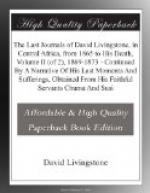The foray above mentioned was undertaken by Katomba for twenty goats from Kassessa!—ten men lost for twenty goats, but they will think twice before they try another foray.
A small bird follows the “Sassassa” or Buceros cristata. It screams and pecks at his tail till he discharges the contents of his bowels, and then leaves him; it is called “play” by the natives, and by the Suaheli “Utane” or “Msaha”—fun or wit; he follows other birds in the same merciless way, screaming and pecking to produce purging; Manyuema call this bird “Mambambwa.” The buffalo bird warns its big friend of danger, by calling “Chachacha,” and the rhinoceros bird cries out, “Tye, tye, tye, tye,” for the same purpose. The Manyuema call the buffalo bird “Mojela,” and the Suaheli, “Chassa.” A climbing plant in Africa is known as “Ntulungope,” which mixed with flour of dura kills mice; they swarm in our camp and destroy everything, but Ntulungope is not near this.
The Arabs tell me that one dollar a day is ample for provisions for a large family at Zanzibar; the food consists of wheat, rice, flesh of goats or ox, fowls, bananas, milk, butter, sugar, eggs, mangoes, and potatoes. Ambergris is boiled in milk and sugar, and used by the Hindoos as a means of increasing blood in their systems; a small quantity is a dose; it is found along the shore of the sea at Barawa or Brava, and at Madagascar, as if the sperm whale got rid of it while alive. Lamoo or Amu is wealthy, and well supplied with everything, as grapes, peaches, wheat, cattle, camels, &c. The trade is chiefly with Madagascar: the houses are richly furnished with furniture, dishes from India, &c. At Garaganza there are hundreds of Arab traders, there too all fruits abound, and the climate is healthy, from its elevation. Why cannot we missionaries imitate these Arabs in living on heights?
24th November, 1870.—Herpes is common at the plantations in Zanzibar, but the close crowding of the houses in the town they think prevents it; the lips and mouth are affected, and constipation sets in for three days, all this is cured by going over to the mainland. Affections of the lungs are healed by residence at Bariwa or Brava, and also on the mainland. The Tafori of Halfani took my letters from Ujiji, but who the person employed is I do not know.




